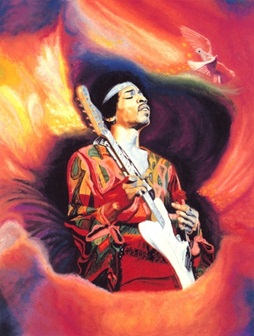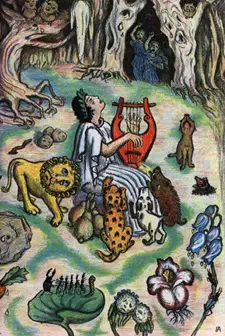|
TRANSLATE THIS ARTICLE
Integral World: Exploring Theories of Everything
An independent forum for a critical discussion of the integral philosophy of Ken Wilber
 Brad Reynolds did graduate work at the California Institute of Integral Studies (CIIS) before leaving to study under Ken Wilber for a decade, and published two books reviewing Wilber's work: Embracing Reality: The Integral Vision of Ken Wilber (Tarcher, 2004), Where's Wilber At?: Ken Wilber's Integral Vision in the New Millennium (Paragon House, 2006) and God's Great Tradition of Global Wisdom: Guru Yoga-Satsang in the Integral Age (Bright Alliance, 2021). Visit: http://integralartandstudies.com Brad Reynolds did graduate work at the California Institute of Integral Studies (CIIS) before leaving to study under Ken Wilber for a decade, and published two books reviewing Wilber's work: Embracing Reality: The Integral Vision of Ken Wilber (Tarcher, 2004), Where's Wilber At?: Ken Wilber's Integral Vision in the New Millennium (Paragon House, 2006) and God's Great Tradition of Global Wisdom: Guru Yoga-Satsang in the Integral Age (Bright Alliance, 2021). Visit: http://integralartandstudies.com
Jimi Hendrix Live In MauiA Vibratory Sound-Color Experience, Part OneBrad ReynoldsAll Jimi Hendrix images, live concert photos, and lyrics are owned by Experience Hendrix, L.L.C.; used here for scholarship purposes only. 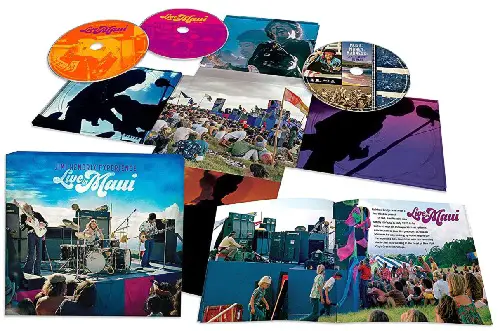 J imi Hendrix Experience Live In Maui, an outdoor concert played on July 30, 1970, is a very welcome release from Experience Hendrix, L.L.C.—giving us a sparkling 2-CD (or 3-LP), 1 DVD box set full of images and sounds (released on November 20, 2020, over fifty years later). The sound quality, in remastered stereo and 5.1 surround sound, is stunning, as is the restoration of the available concert film footage from both shows. The accompanying DVD documentary is thoroughly enjoyable as well, masterfully directed by resident Hendrix scholar John McDermott, giving us lots of background info with key players from the original concert and Rainbow Bridge film (yet oddly missing Pat Hartley, the film's central actress). The hour and half documentary—with the sensationalized (and poor) title Music, Money, Madness—gives us a real taste of the excitement and special pleasure of attending an outdoor Jimi Hendrix concert during the middle of the day, in a stunning natural setting, at the base of the Haleakala Crater with the master guitarist, the New Age Voodoo Child, in full flight. Wow! 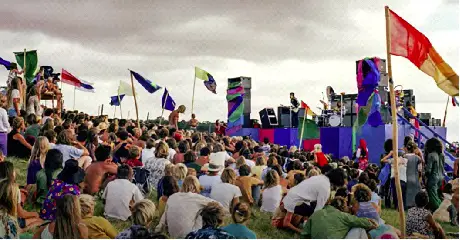 The day was stunning, the people were beautiful, the energy was magnetic, the stars were aligned (as the crowd sat in zodiac zones divided into their astrological sun signs), the colorful banners were fluttering in synchronized harmony as minds were being blown (including gusts of wind up to 30-40 mph). The music that day was magical, even mystical, whether you were tripping or not; and if you were: hold on and let go! This Maui show is in fact the full-blown Jimi Hendrix Experience! And now we can re-experience it over fifty years later thanks to the stellar efforts of producers Janie Hendrix, John McDermott, and the master of Jimi's studio sound, Eddie Kramer, Hendrix's original recording engineer. In the documentary bassist Billy Cox affirmed—what our ears can abundantly hear—that “Jimi enjoyed it; you could see Jimi was at his best!” Indeed! Although it was less than two months before Hendrix's tragic death (on September 18), the master guitarist had continued to mature in playing and songwriting throughout his career so he was at the peak of his powers. Despite all of the mismanagement, overworking, problems and complications in Hendrix's life, it seems his creative soul was vibrant and clear in transcending the money and madness with the music of his glorious genius on electric guitar. Almost all of his biographers and reviewers tend to focus on the mounting problems, the pretentiousness of the film, Rainbow Bridge, being made on Maui, and endless other complaints; however, the music itself sings with brilliance that will last for countless generations into the future. 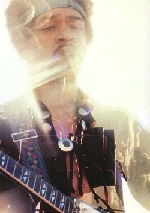
Jimi's message of higher consciousness, or peace, love, and understanding, was impregnated in his new songs as he showed a renewed desire to reach out to the world's people and transform their minds. He called it an “awakening state” that his music would sometimes invoke, if heard properly; thus his new songs, combined with the best of his older ones, provided the vehicle—the Rainbow Bridge, if you will—to mystical awakening and musical bliss. This boxed set allows you to hear clearly why, though the documentary provides few clues to this perspective. Sadly, the filmmakers of Rainbow Bridge were more interested in “space brothers” and UFOs than actual mysticism and yogic enlightenment, so everyone falls short, except for Jimi's music. The summer of 1970 brought to completion the Cry of Love Tour that had began in the spring, with Billy Cox on bass (from the Band of Gypsys) and Mitch Mitchell on drums (from the original Experience trio). The last show of the tour was scheduled for Honolulu on August 1, two days after the Maui outdoor gig. Since June, however, Jimi had been mostly recording in his brand new, yet unopened, Electric Lady Studio in New York City—the most advanced (and comfortable) recording studio in the world. He had ventured out for the July 4th Atlanta Pop Festival, and the New York Pop Festival at Randall Island on July 17, premiering several of the new songs. Indeed, the need for financial capital to finish the studio was part of manager Michael Jeffery's motivation for doing the film with an accompanying soundtrack album (thus convincing Warner Brothers to invest in the ill-fated scheme). Electric Lady, designed and engineered by Kramer, who also oversaw the cleanup of the current Maui release, allowed the guitarist to experiment and lay down new multi-track songs and soundscapes that still sound fresh and sublime. Consequently, Hendrix had a bounty of new tunes, several of which he played that day on the slopes of Haleakala, translated as the “House of the Sun,” including the aptly-named “Hey Baby (New Rising Sun),” about a goddess (actually Hendrix) who comes down to Earth to spread around peace of mind and a whole lotta love. The lyrics make clear that Jimi was moving in a renewed direction to offer hope and inspiration for better days ahead—the “first rays of the new rising sun,” as he put it (also a possible title for his forthcoming double-LP that was aborted after his untimely death). In this case, Hendrix was debuting a stash of unheard songs at the concert (and during the months-long tour) that the audience did not know—such as “Hey Baby,” “Freedom,” “In From The Storm,” “Ezy Ryder,” “Straight Ahead,” “Dolly Dagger,” and “Midnight Lightning,” plus some incredible instrumental jams (such as “Beginnings,” also known as “Jam Back At the House”)—but no one seemed to mind. The Sixties was a time of experimentation and musicians were writing as fast as they could record, so people were open to new ideas and songs, not just the popular hits (though they enjoyed those too). Just listen to the words and music and go along for the ride, they felt, no previous experience necessary… yet it helps if your mind and thoughts are being blown away by the potent power of psychedelics. The music created a safe zone to trip out, especially when in Nature, and no one did it better than Jimi Hendrix. The LSD-laced crowd was definitely in the zone as the film footage amply shows. The audience, perhaps 400 people or so, were mostly local hippie residents from Maui, since it was an unadvertised free concert spread by word-of-mouth, or the “coconut wireless,” so everyone was living in the moment with no expectations. They congregated in a cow pasture on a cattle ranch (owned by the Baldwin family) near Olinda, walking miles through green fields to the lower slopes of the inactive volcano to hear their Electric Prophet spin his enchanting sounds and tales of mind expansion. The crew and Hendrix stayed and filmed at nearby Seabury Hall, a beautiful local Methodist girl's school rented for the purpose of making a spontaneous film (the security deposit was not returned). Now, today, with this 2020 box set, we too can experience what they heard, but hear it even more clearly; see some of what they saw, but mostly, as they did, open ourselves to Jimi's message of sound and soul. 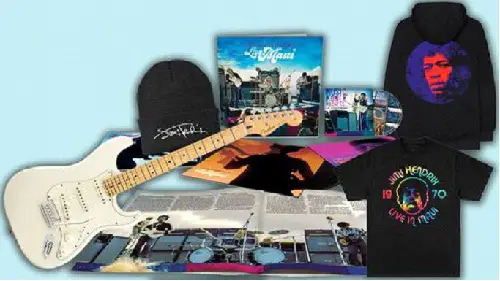 Since most reviews of this brilliant release, which is a gift from the music gods (and the Hendrix Estate), focus on the production, the time and place, the history, and packaging, etc., I want to turn our attention to the music, the songs themselves, and the impact they will continue to have for future generations. Hendrix's music is timeless, for it speaks to your immortal soul, not just your ears and mind. If heard properly, it can initiate people into higher states of consciousness. Jimi's sound vibrations can quiet the mind, open the heart and higher chakras, and help you see and know and feel things you've never felt or known before. This is the magic of the musical Maestro, the Voodoo priest of the Electric Church as he brings his cry of love to all who will turn it up loud enough and go deep enough inside to have the real Jimi Hendrix Experience. 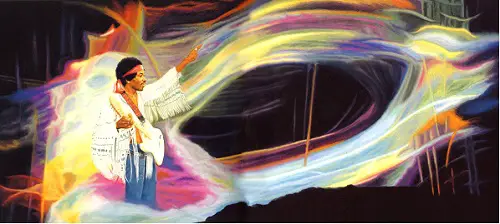
“The Color of Music”—painting by Monika Dannemann
Electric Church Music: Higher Consciousness Through Sound and ColorsS ure, everyone has their own opinions of what Hendrix was trying to do (or not do) with his music and message, probably most believing he was only playing great guitar, writing groovy songs, and being a flamboyant rock star. Therefore there's no reason to read anything more into it. But I disagree. From the first time I heard Hendrix (while he was still alive), I felt he was doing something more than his contemporaries to expand our minds and enlighten our souls. Hendrix understood higher consciousness and God, whether you believe that or not. For one, Hendrix called his music “Electric Church Music” and “Sky Church” (for outdoor shows), or as another example, his most recent release (at the time), the live Band of Gypsys album (released March 1970), was produced by himself as “Heaven Research.” On one of those Band of Gypsys songs, “Message To Love,” Hendrix sang: “Well, I am what I am, thank God. Some people don't understand (that they're God).” On another song he preached about the “Power of Soul” (singing “with the power of soul anything is possible”), and so on. Just a year earlier in 1969, when arriving in Honolulu for some shows, a local reporter (Ben Wood) asked him why he was so successful to which Jimi simply stated: “I attribute my success to God. I'm really a Messenger of God.” [McDermott/Kramer, p. 197] Or there was his interview on the Dick Cavett Show (in September 1969, soon after Woodstock) where he explained that his Electric Church uses electricity and electric guitars where, he tells us, “we're playing for our sound to go inside the soul of a person and see if they can awaken some kind thing in their minds cause, you know, there's so many sleeping people.” In January 1969, the “rock god” clearly explained: “We call our music Electric Church Music, 'cos it's like a religion to us.” Perhaps this “mystical” talk doesn't interest you, but it certainly interested Hendrix, as well as the people putting together the film Rainbow Bridge, although they were far less successful in conveying the profound subtleties of mystical states and higher consciousness than Hendrix was. Thus, I suggest just listen to Hendrix and his music because this new remastered release provides ample evidence that Jimi was trying to blow minds and turn on the world… and it still works even today! Turn it up and find out! 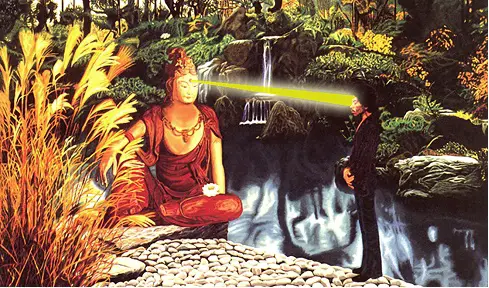 After his death, I continued listening to Hendrix as I matured in my own spiritual development (without drugs) through meditation and sadhana or yogic spiritual disciplines while studying the world's sacred texts—the Great Tradition of Global Wisdom (as one of my books puts it)—and I discovered that Jimi's message of lyrics and sound were meant to awaken, not just entertain. I found out in interviews (like the ones above) he was fairly conscious of this task (unlike most of his contemporaries). Mostly, of course, he was a creative musical genius reflecting his times (the Sixties), not a qualified yogic Master or Guru, thus he didn't articulate his views through the language of Yoga but only through his music and lyrics. Nonetheless, his vision and intentions can be seen through those spiritual “eyes of knowing,” so to speak, through the “Eye of Spirit” (see philosopher Ken Wilber's Integral Theory for further consideration). Still, there's no need to exaggerate Jimi's spiritual development, since his primary fallacy was that he had no yoga, no repeatable techniques for consciousness development other than the sound of his music (and perhaps some psychoactive drugs). Maybe, if he lived, he would have explored the yogas of the East and meditation, since these views became more popular in the '70s, such as with the Beatle George Harrison. Who knows? Nevertheless, Jimi Hendrix's free-form experiment with sound, lights, message, and colors—which surely would have grown into gorgeous multi-media extravaganzas and opulent tours, if he would have lived—are revolutionary for his time and should continue to have a profound influence as our emerging global culture evolves. Jimi Hendrix, without doubt, was a musical prophet ahead of his time which is why his music is still vibrant and relevant now even fifty years later. Musical gems, like this box set, will make sure his legacy lasts for centuries. 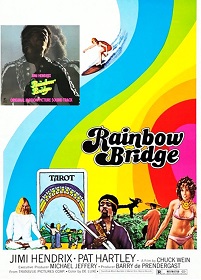
The film Rainbow Bridge, which Hendrix himself had no direct involvement in making, was directed by the “Wizard” Chuck Wein who tried to present a yogic vision underlying its message and was also the reason behind the concert (other than the fact that Jimi's manager, Michael Jeffery, was heavily invested). Nevertheless, the movie itself was a boring flop, both commercially and critically, although they say the four-hour version was better, though that's hard to imagine due to its pretentious preaching and haphazard, no-script editing. Much of it comes off as trite and pedantic, with poor special effects and rambling stoned-out speeches, yet, in a certain sense, that was the Sixties. Thus, most people hated it, or at least were embarrassed by it. Only Hendrix's concert footage, in the last 20 minutes or so, redeemed the movie at all and got people into the theaters. Hence, we can be thankful, I suppose, that the movie Rainbow Bridge was not included in this package, and that the remaining footage of Jimi playing is what will be remembered for posterity. Hendrix himself does not disappoint! In fact, as the documentary explains, the real “rainbow bridge” is called antakarana (in Sanskrit) which is a bridge from the unenlightened to the Enlightened, from the secular to the sacred. In esoteric (yogic) terms, it is about the ascension from the lower material world (or chakras) through the heart and higher chakras (such as the “third eye”) to connect a person with the Energy of God, the Earth, and the universe to Infinity. Jimi was in tune with this message, although it was his music, not the movie, that was his vehicle of expression. Whether or not you, as the listener, tune into this reality is up to you, but it must be admitted that Hendrix did see things this way, as people around him confess (including some interviewed in the documentary). For example, there was a psychic woman, Emilie Touraine (not interviewed on the DVD), who Jimi met soon after arriving on Maui, and who showed him her research into sounds and colors and how his songs were aligned with that vision. Jimi readily agreed so they quickly fell into deep conversations, especially since earlier songs from his previous albums, such as Bold As Love and May This Be Love (aka, Waterfall), clearly show his interest in sound and colors. Known as synaesthesia (the merging of different senses), it was also how Jimi and his cutting-edge guitar effects technician, Roger Mayer, would talk about the different pedal effects they wanted to produce. Indeed, it was Touraine who inspired the cosmic title to the concert: “The Rainbow Bridge Vibratory Color/Sound Experiment” that took place on that special afternoon on the second to last day of July on the island of Maui in 1970. 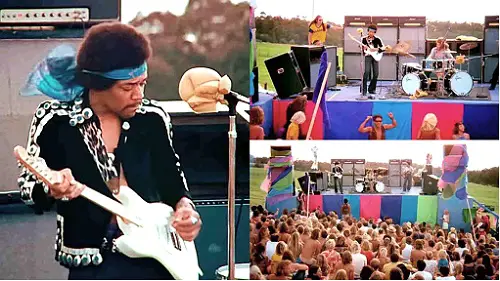 A Cosmic Day on Maui Seen TodayA lthough initially a cloudy day with some dark clouds overhead, Jimi's vibratory magic seemed to clear the skies as the show progressed since the sun emerged with blue skies and billowing white cumulus clouds. Maybe it was the opening “OM” chant from the crowd, or just the wind that blew the clouds away on this blissful “perfect” day as Hendrix spun his musical magic. It is beyond fascinating to finally see and hear the remastered film footage from the actual shows, although some is missing due to poor planning and technical difficulties. Supposedly there were four 35mm cameras shooting, yet we do not get many multi-camera edits, and since they only had 1000-foot film magazines (running for roughly eleven minutes), we often get an on-screen graphic saying “ALL CAMERAS STOPPED” while the song continues to play. Therefore, kudos to Experience Hendrix, the producers of this box set, for giving us all of the footage they have! It's priceless! (Actually, about $50 per package with the remastered CDs or vinyl albums.) While it is awesome to see the clear film footage taken in the light of day, perhaps these shows of Hendrix's Electric Sky Church are best listened to in the dark (or with headphones), so the mind is free to wander where the music and lyrics will take you. Fortunately, ALL of the music from both shows are now remastered in all its brilliance and glory. (Sadly, especially during the second set, the film footage is minus several important songs but what is there is stunning). Sound engineer Eddie Kramer once again shows how lucky we are to have Jimi's original engineer taking great care to perfect these recordings for posterity; Jimi would be proud (and very happy, I believe). Thank you, Eddie and Experience Hendrix! 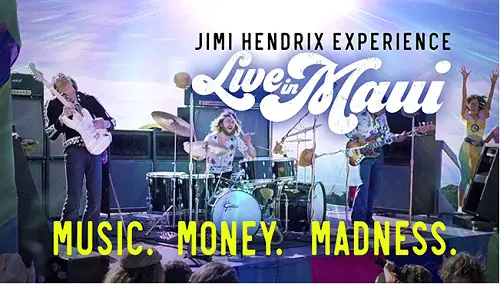 Personally, I love hearing the music in my car with the landscape rolling by so I can turn it up as loud as I want—and I want it VERY loud, per Jimi's instructions. However you can manage it, turn it up and enter the Hendrix Sound-Color Vibratory Zone; you won't be disappointed with these masterful soundscapes. It is obvious that it is the music that matters the most, not the movie. Naturally, however, the film footage is wonderful to see as well since you get to witness Hendrix in his flights of ecstasy, often showing his humor and the obvious fun he was having when playing in a good environment in front of an excited crowd full of groovy people. The music of Jimi Hendrix will take you anywhere and everywhere, depending on your listening circumstance. It's all a state of mind… and the quality of your stereo. In these two live shows in Maui, Jimi's three-piece band takes you to the outskirts of Infinity and back, as any Voodoo Child is wont to do. Next, let's review the music and songs themselves, with a slant to their spiritual essence. After all, according to Jimi: “It's the sounds we make that are important…. It's all spiritual.” [International Times, 1969]. Or, as he also explained in 1969: “We're going to make our music into a religion.” [Nancy Carter interview, LA] “Yes, I have said that I am electric religion—because it's all about religion, not Christianity…. I see in front of me a universal religion, containing all beliefs, containing the essence of them all.” [Denmark, September 2, 1970] Or, even more direct: “Music is my religion.” [Melody Maker, January 1969] 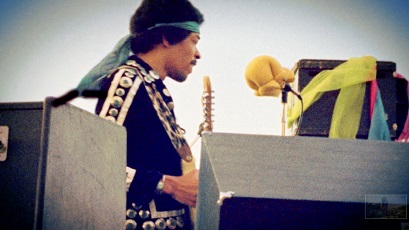 Honestly, the music and message of Jimi Hendrix reminds me of the ancient Greek sage and philosopher Orpheus (ca. 750 BCE), who also played an enchanting stringed lyre—the ancient guitar—while initiating people into the sacred Mysteries of life and death. Orpheus' fame told about how his lyre playing and enlightening lyrics released soothing sounds and teachings for all to hear. He calls us to ekstasis, or “going beyond self” to feel our prior unity with the divine nature of all things, our unity with the kosmos or the “order of the universe.” His music pacified wild beasts, including warriors, so that not only people but the creatures of nature, animals, plants, and trees, even stones, would bow down in adoration and peace of mind. The Orphic Mysteries were the mystical fountain of Western philosophy, from Pythagoras to Plato to Plotinus, touching upon the wisdom of the East. It seems to me Orpheus lived again, metaphorically speaking, in the electric guitar soundscapes of James Marshall Hendrix, the shamanic Voodoo Child and Magic Boy—the Astro Man and Ezy Ryder—of the Electronic-Atomic Age. In truth, the real Jimi Hendrix experience is ultimately a state of mind. Are you experienced?
|
